|
|
|
Our
Letter of Ownership to the Carpathian...
|
|
|
Our Letter of Ownership to the Carpathian Basin is the Rovás (Runic) Script |
Az írás részlet a megjelenés előtt álló Selected Studies in Hungarian History című könyvből
I. The meaning and importance of the Hun-Magyar (Hungarian) rovás (runic) script
The runic script ('rovás'
writing, lit.: carved writing) is the ancient script of the Magyars. Its exceptional
significance lies in the fact that it verifies the ancient Hungarian presence
in the Carpathian Basin of at least eight- to nine-thousand years, and the Magyar-Scythian-Hun-Avar
continuity.
Hungarian chroniclers and
scientists, like Simon Kézai, Márk Kálti, János
Thúróczy, Antal Verancsics, István Szamosközi,
János Thelegdi, János Kájoni, Mátyás Bél,
among many others, call this script Scythian-Hun writing. The expression rovásírás
was coined by the leading sculptor János Fadrusz at the beginning
of the 20th century. It is more accurate to use the term Scythian writing, even
though, according to some relics, this writing already existed 20 thousand years
ago in the Paleolithic Age. We do not know by what name the Hungarian ancestors,
who carved these letters onto wooden sticks and lived at that time in the Carpathian
Basin, called themselves.
The ancestors of the Hungarians used this writing in the entire Carpathian Basin and helped its spread to distant lands. The written words that remained among the common people indicate that there was no illiteracy from the most ancient times on. Everyone, from the simple shepherd boy to the king, knew how to write.
II. The place of the Magyar runic script in the universal history of writing
The writing systems of
the world are organized into the following categories: hiero-glyphs, ideograms,
and syllabic and phonetic writing in which every sound (phoneme) is marked by
a separate letter (grapheme).
The internationally accepted
theory, which holds that the first phonetic writing was created by the ancient
Semites of the Sinai some 3,500 years ago, can be disputed on two grounds. One
reason for opposing this view is that, in this Sinaitic writing, the vowels
were not marked, so it cannot be considered to be a phonetic writing that follows
the sounds. The consonants, which are lined up side by side - in absence of
vowels - can be interpreted in several ways. For example the "g.m.l."
can mean both a camel and the rope of a ship, truly different meanings.
In the ancient Magyar runic
script, the vowels - A (Á), E (É), I, O, Ö, U, Ü - all had a separate letter.
The Hungarian language owes its beauty partly to the fact that it avoids the
clustering of consonants.
The second argument that
the Sinaitic writing could not have been the first phonetic writing comes from
the fact that neither the scholars who hold this view nor the Hungarian writing
experts were sufficiently familiar with the ancient Magyar system of writing.
I. G. Gelb, of Polish ancestry, was a professor at the University of
Chicago and was considered to be one of the greatest international experts in
writing. He stated that the Magyar runic alphabet consists of 12 (!) characters,
even though a copy of the Gyergyószárhegy stick calendar of the 12th century
had already been known for decades, and also the 32 runic characters of the
Nicholsburg alphabet, which originated from before 1483 (the former is owned
by the Library of Bologna, the latter by the National Széchényi Library in Budapest).
Even the knowledge of the
Hungarian experts is scant or inaccurate. Béla Kéki's book Az írás
története (The history of writing) shows the alphabet of the afore-mentioned
stick-calendar with many mistakes and the direction of the Konstantinápolyi
Felirat 1
(Constantinople Writing) from 1515 is incorrectly portrayed in his book.
In the Magyar runic script,
every sound of the Hungarian language has a letter and, therefore, we can state
that this writing developed along with the language. It was not borrowed or
adopted from someone else. When we were forced to change over to the Latin letters
in the 11th and 12th centuries, there were no letters for 13 of the sounds of
the Hungarian language (TY, GY, NY, LY, SZ, ZS, CS, K, J, Á, É, Ö, Ü). With
this writing system (i.e. Latin), which was completely indequate for the Hungarian
language, the development of literacy was impeded for centuries and Hungarians
were forced to adopt the low level of literacy of contemporary Europe. For example
the word "gyümölcs" (fruit) with Latin letters could be written only
as "gimilc" in the absence of adequate letters, and in the Vizsoly
Bible, they wrote the word "új" (new), as "WY" as late as
in 1590.
Taking into consideration
Hungarian language relics from the Paleolithic, the Tatárlaka discovery, and
archaeologist Zsófia Torma's (1840-1899) discovery of several thousand
written tablets from the banks of the Maros River in Transylvania, we can justly
suppose that the oldest writing on our globe developed in the Carpathian Basin.
The fact that the signs on the Tatárlaka disk are 1,000-1,500 years older than
similar Mesopotamian hieroglyphic signs reinforces the hypothesis that the cradle
of writing was the Carpathian Basin. The Hungarian people, whose ancestors created
these letters, still live there.
The Magyar runic script - considering its age - could not have adopted signs from others, but the ancestors of Hungarians were the disseminators of writing, in many instances. Therefore, we may recognize ancient Magyar letters, with more or less different sound values, for example, in ancient Chinese, in the Pelasgian, Etruscan, ancient Greek, Phoenician and Iberian languages, in the Latin capital characters and in the Türk and German runes. Ferenc Kállay wrote in his book A pogány magyarok vallása (The religion of the pagan Magyars, 1861), that the Pelasgians imported 16 Scythian letters to Greece.
Based upon the testimony of the remaining runic texts, we may safely state that the ancient Magyar runic script was the first alphabetical writing on Earth, formed in the Carpathian Basin, and, being the source, it greatly influenced the later developing writing systems of other peoples.
III. Some significant remains of the Magyar runic script and important milestones
The oldest writing discovered in the Carpathian Basin comes from the Jankovich Cave of Bajót, from a 15-20,000 year old layer. On both sides of the broken off stick, runic-signs are lined up, among which we can also see a probable SK ligature.
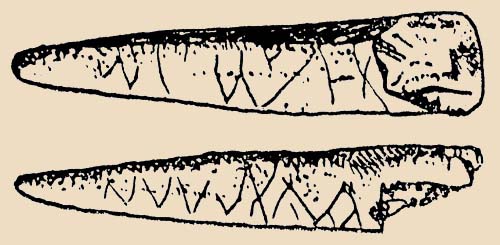
Picture 1
Stick fragments from the Jankovich Cave
In 1961, in a cremation grave in Tatárlaka, archeologists found a burnt clay disk, measuring six inches in diameter, on which the runic signs for the letters Z, Ny and Gy can be seen. Its age is approximately 8,000 years.
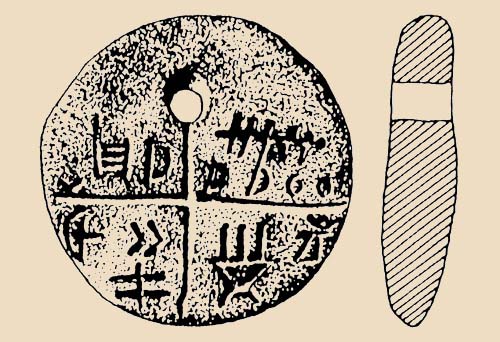
Picture 2
Tatárlaka Disk
Zsófia Torma, the
world's first female archaeologist, excavated 4-6,000 year-old clay disks from
the banks of the Maros, on which writing is found. On several of her finds,
displayed in the Museum of History in Kolozsvár 2,
ligatures are visible.
The picture of a three-thousand year old bronze hatchet-case, which was found on the meadow of Campagna, near Rome, was drawn by archaeologist, John Lubbock, the later Lord Avebury, in his book Prehistoric Times, in 1865. He came to the conclusion that it was made in the Carpathian Basin and it is of Scythian origin. A sentence written in ligatures reads "Segít is, üt is, ró is" ('It helps, it hits and writes too'). It was deciphered by Judge Miklós Debreczenyi in 1914.
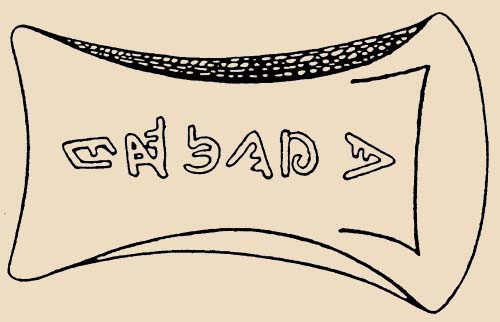
Picture 3
Bronze hatchet case
On 14 of the 23 gold vessels
of the Nagyszentmiklós 3
Treasure, there are runic writings. Researchers place these into the Avar
age. In this writer's opinion, this treasure belonged to Roga, King of the Huns
(390-434) and his family.
On the Szarvas needle holder
of the 7th century Avar period, there are approximately sixty runic signs. Its
extraordinary importance lies in the fact that it was found in the grave of
a female of the common people and so it testifies to the literacy of the Hungarians
(Avars) in an age when not even Charlemagne, Emperor of the Franks could read
and write.
The inscription on a blow-pipe from a 9th-century foundry at Bodrog-Alsóbű, from the time when the Magyar group of Árpád entered the Carpathian Basin, testifies to the literacy of the common people and, at the same time, indicates the high technical level of the foundries which superseded those of Europe.
L.F. Marsigli, an
Italian military engineer, copied a stick calendar with runic writing, in 1690,
in the Franciscan Abbey of Gyergyószárhegy. The last word of this 200 letter
inscription is Áldás ('blessing') which is the greeting of the Táltos
4.
The Nicholsburg Alphabet was written before 1483 and it can be seen at a large exhibition at the National Széchenyi Library.
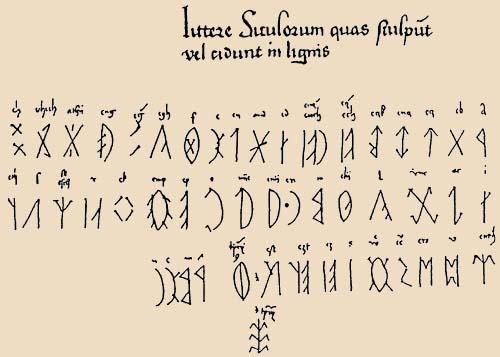
Picture 4
The Nicholsburg Alphabet
The inscription from the Csíkszentmiklós 5 Church (according to other sources the Csíkszentmárton 6 Church), built in 1501, is another proof of the literacy of the common people and it contains the names of the builders of the church. We have only copies of it.
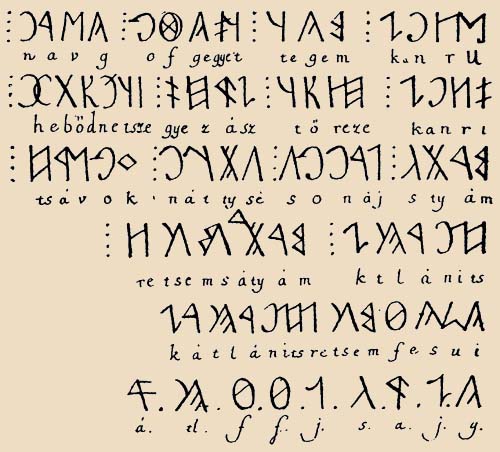
Picture 5
Inscription from the Csíkszentmiklós Church
The few afore-mentioned
examples of the Magyar runic script have helped us familiarize ourselves - without
the claim of completeness - with those who preserved the most important part
of the ancient Hungarian culture, the writing. This includes the following:
István Szamosközi (1570-1612),
historian of István Bocskai, recorded his visit to the Library of the Count
of Florence, where he saw a printed (!) book with Scythian letters. We also
have his notes written in runic script.
In 1598, János Thelegdi (1574-1647), later Roman Catholic prelate, assembled a sixteen page-long schoolbook about the rules of the ancient script. He uses the Pater Noster and the Credo as text-exercises. Regrettably, we have it only in faulty copies. Thelegdi was also the writer of the book Rudimenta, Priscae hunnorum linguae... (The rudimentary elements of the old language of the Huns). His goal was to spread again the knowledge of the runic writing.
János Kájoni (1629-1687),
Franciscan friar, who was a collector of folk songs, an organ builder and the
developer of a printing press, was active in preserving runic alphabets.
György Muzsnai, Unitarian
minister, prepared the inscription of the Énlaka 7
church in 1686.
Lutheran bishop Mátyás
Bél (1684-1749) had a significant collection of runic texts.
Péter Bod (1712-1769)
a pastor of the Protestant Church, was a writer, who also prepared a dictionary.
A runic inscription and a list of letters have remained from his work.
Károly Antal Fischer
(1842-1926) is the author of the book A hun-magyar írás és annak fennmaradt
emlékei (The Hun-Magyar writing and its remaining texts).
János Fadrusz (1859-1903) was one of the greatest Hungarian sculptors and the creator of the Tuhutum statue in Zilah 8 which displays runic writing.
Gyula Sebestyén (1864-1943)
was an ethnographer, who has written extensively about the runic script. He
erected a memorial stone with runic writing in front of his villa at Lake Balaton.
Adorján Magyar (1887-1978) was a linguist, ethnographer, historian, artist and author of several articles concerning the runic script. 9
Anna Walter Fehér
(1915-?) was a historian of writing and publisher of a related periodical; she
has written a two-volume book which describes the runic writing, titled Az
ékírástól a rovásírásig (From the cuneiform to the runic script).
Sándor Forrai (1913-2007) professor and Protestant presbyter, was the author of several books concerning the ancient Magyar runic script, and the organizer of several exhibitions which travel around Hungary.
IV. Destroyed Magyar runic
texts
As we have already seen, the Magyar runic script contained a sign for every
sound of the Hungarian language, so that it could be perfectly written down.
In 1985, Sándor Forrai wrote the following: "...The writing of the Hungarian
language with Latin letters was possible only with great distortion or not at
all. The reader will always be a witness to the battle which our language fought
against the intruding foreign letters."
Then why don't the Hungarians
use their ancient writing as the Chinese, Japanese, Greeks, Arabs and Hebrews
do? The answer can be found in the first sentences of this study: because it
proves the ancient origin of the Hungarians in the Carpathian Basin and it is
their letter of ownership to this region. It is for this reason that the cultural
genocide began forcefully in the 10th and 11th centuries and has since continued.
The Codices with runic writing and the carved runic sticks were burned; the
Táltos were killed or incarcerated. Beginning with King St. István, all the
kings - with the exception of King Mátyás in the 15th century - accepted the
orders of the Roman Pope to destroy the so called pagan culture.
András I., son of Vazul
(also known as Vászoly), 10
issued an edict in 1047, which, under penalty of loss of wealth and head, forbade
the use of the "ancient Scythian national religion" and the pagan
writing. Béla, the younger brother of András I., eradicated the old Székely
(Sicul) Hungarian names expressing rank. He had the old names of families, castles
and towns changed to the names of saints and had the ancient family libraries
burnt.
Mátyás Jenő Fehér
writes in his book Középkori magyar inkvizíció (The inquisition of
the Magyars in the Middle Ages) that there were Magyar documents and books
well before the Halotti Beszéd (Funeral Sermon) and the Mária
Siralom (The lament of Mary). 11
Unknown hands removed the
book, printed in Scythian letters, which István Szamosközi saw in 1592, from
the Library of the Duke of Florence. His report is verified by Antonius Maginus,
an Italian geographer, who described this book in 1595.
We know from Anna Walter
Fehér that the correspondence in runic writing of Prince Ferenc Rákóczi II (who
lived in exile in Rodosto, Turkey) with the Spanish Court, where it was filed,
was later made to disappear.
The notes of the friar and
scientist János Kájoni, dated 1673, dealing with the "Hun-Magyar Runic
Script" disappeared as well.
The collection of the runic
writing of Mátyás Bél, and Pál Király, literary historian and
director of a teacher's training college (20th century) also mysteriously vanished.
Balázs Orbán (1830-1890),
the chronicler of the Székely lands, mentions in the section dealing with the
runic inscription of the Énlaka Church, which was still visible then, that "two
other such Hun-Scythian inscriptions existed in Csík, in the Csíkszentmiklós
and Gyergyószentmiklós churches, but both were destroyed by ignorant priests
who considered them pagan remnants."
Bálint Gábor Szentkatolnai
(1844-1913) was a Hungarian scholar who spoke more than thirty languages. His
collection of runic writings was ordered to be burnt by Pál Hunfalvy (formerly
Hunsdorfer), the chief librarian of the Hungarian Academy of Sciences, in order
to prove his thesis that the Magyars did not have their own writing prior to
the adoption of Christianity. Researchers of the 20th century, János Jerney,
Károly Antal Fischer and Károly Szabó looked in vain for these
writings of the Hungarian ancestors in the manuscript department, where they
were originally registered.
Adorján Magyar writes
that the Austrian government hired a secret agent by the name of Stromler, whose
duty was the destruction of the ancient Magyar cultural treasures. He was later
appointed to a leading position under the name of Thallóczy in the Hungarian
Academy of Sciences.
This list contains only
a small portion of the runic writings which are mentioned in authenticated sources
and which cannot be found in their original material form. Many more could have
been stored in the 150 castles across historical Hungary, which were considered
masterpieces from a strategic and architectural point of view and which the
Habsburg Emperor Leopold ordered to be destroyed at the end of the 17th century.
V. The major rules of the Magyar runic script and their mastery
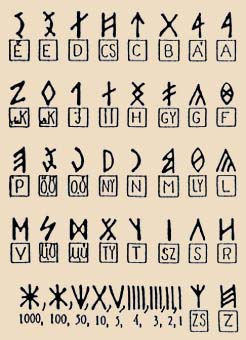 |
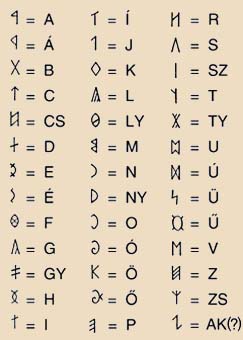 |
|
Alphabet by Adorján Magyar |
Alphabet by Sándor Forrai |
|
Picture
6 |
|
1. The Magyar runic script
has to be written from right to left because this is how most of the old samples
were written. Writing from left to right is also possible but it is contrary
to the traditional use. In this case, the letters have to be turned around and
face from the left to the right.
2. The words have to be
separated by spaces. Lower case and capital letters are not marked separately.
Punctuation marks are the same as in the Latin script.
3. In the runic writing
there are two letter K-s in use. According to Adorján Magyar, one is used word-finally,
the other within the word. In Sándor Forrai's opinion, the use of the two different
K letters depends upon the order of the vowels within the word. According to
the research of Klára Friedrich, the available runic writings do not
verify these theses. It is simpler - and this shortcut is also agreed upon by
Sándor Forrai - that we use only the ![]() -sign
as the letter K. In the past, not only the (e)f, (e)l, (e)m, (e)n, (e)ny, (e)r,
(e)s, (e)sz sounds were preceeded by the vowel e but all consonants.
Therefore the (e)b, (e)c, (e)cs...and the..(e)k, which is represented by the
runic sign
-sign
as the letter K. In the past, not only the (e)f, (e)l, (e)m, (e)n, (e)ny, (e)r,
(e)s, (e)sz sounds were preceeded by the vowel e but all consonants.
Therefore the (e)b, (e)c, (e)cs...and the..(e)k, which is represented by the
runic sign ![]() .
.
4. It is a further important
rule that we use only those letters which are attested in ancient runic texts.
5. There are no letters
Q, W, X, Y in the Magyar runic script. They are represented as follows:

Picture 7
The representation of q, w, x, and y
The original rovás is done
upon a surface by a carving or scratching technique; the runic writing today
can be conducted with a pencil, pen, or brush. The ancient letters are beautiful,
pleasing and also suitable for decoration. At the Sashalom-Rákosszentmihály
Church, in the XVI. district of Budapest, the National Anthem and the
Szózat 12
can be seen in runic script on two large enamel tiles.
The Magyar runic script is written from right to left, according to tradition. The ancient writings, like the Egyptian hieratic writing, the Etruscan, Pelasgian, Ancient-Greek, Phoenician and Latin capital letters usually followed a right to left path. In Gyula Sebestyén's opinion, the direction of writing began to change when the linear, cursive writing took over. Three old Magyar runic relics were written from left to right to increase the difficulty of reading it in some politically dangerous situations. These are the following:
- The script in the Hungarian language, by Tamás Keteji Székely, from 1515, on the wall of the house of the Constantinople Legation;
- A poem by István Szamosközi, written against Emperor Rudolf Habsburg in 1604, in Latin;
- The letter from Peru, from 1756, written by János Zakariás, a Jesuit priest, in the Latin language.
Writing from right to left
does not cause any difficulty even for pupils in lower grades, and those who
are left-handed mention that it is easier for them to do so. There are some
runic relics which were written in a vertical form, like the Margitsziget
Stone (Margaret Island, Budapest) from the 13th century. On cemetery memorial
carvings and on Székely gates we can also find runic texts, written in this
vertical manner.
The characteristic of the
runic script is that it is written in capital letters; the size of the letters
is traditionally equal. Presently, the first letters of the sentences and the
first letters of personal names can be marked with capitals, which helps the
reading process.
Regrettably, there are no surviving runic relics which might give us a steadfast rule concerning punctuation. Today, we use the same punctuation that the Latin language has. Runic writing can be abbreviated in two ways. One way is the ligature which gives many playful alternatives for writing in the runic script. The following illustrations show Ferenc Dittler's ligatures.
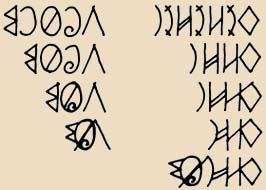 |
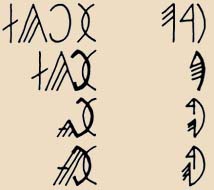 |
|
Picture
8 |
|
Another possibility for
abbreviation comes with the omission of the letter E, although to facilitate
understanding, this letter always needs to be present word-finally. Other vowels
may be left out too, if there are several of the same vowels in a word; however,
here the first vowel has to be written because only the omission of the vowel
E is unambiguous.
Additionally, in times past,
the long vowels were not marked separately; we find the first such forms only
after the 16th century.
VI. Numerical signs in the Magyar runic script
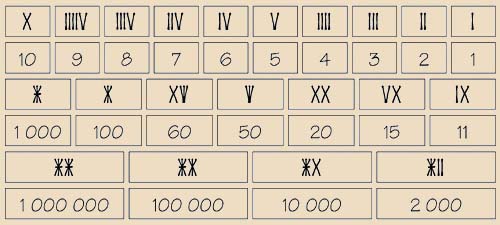
Picture 9
Numerical signs in the Magyar runic script
The writing of the numbers in the Magyar runic script also proceeds from right to left. The ancestors of the Hungarians managed their accounting in a very logical manner. They carved the debtor's name into a wooden base, or burned the identification sign of the shepherd onto it and then carved the owed sum, or the number of the animals. After that the wooden plank was split down in the middle and each of the parties - the debtor and the lender - kept one half. They then went on and continued their usual business. When the time came to account for the lent sum, the two halves of the split sticks were placed side-by-side and the two had to match, thus preventing any possibility of cheating.
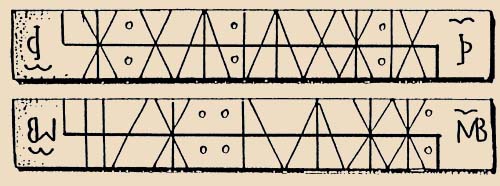
Picture 10
Runic sticks (from Anna Bihari - Éva Pócs: Képes magyar néprajz, 1985)
The ancestors of the Hungarians
were also able to accomplish certain computations with the runic numbers but
we have no old examples of these. The majority of runic experts believe that
it is not possible to do computations with runic numbers. To prove them wrong,
the graphic artist József Barta worked out a technique which makes the
computation of the four basic mathematical computations possible and which was
published in my 2006 booklet Új Rovásírás Tankönyv és Szakköri Ötlettár
(New Rovás textbook with suggestions for writing groups).
The runic script is very
easy to learn; children in the lower grades are able to acquire it in only 4-5
sessions, including the writing of numbers and the ligatures. It should be mentioned
that the best age for beginning to learn this sign system is after third grade,
around age 9. This is partly so because, in this way, no-one can claim that
children's potential problems in learning to read and write the Latin alphabet
are due to interference from the runic script. 13
The learning of the runic writing has no upper age-limit. Mrs. János Egerszegi,
the mother of swimming champion, Krisztina Egerszegi, learned runic writing
as a grandmother and transcribed the entire epic poem János vitéz by
poet Sándor Petőfi into runic script.
VII. Preservation
and promotion of the runic script
Hungarians have been able
to preserve the writing-system of their ancestors and its remaining examples
in spite of prohibitions and persecutions. We are grateful to those who chiseled
it into stone, carved it into wood, scratched it into clay, spindle-heads, needle
holders or who wrote it on parchment, slate, paper and the walls of churches.
The scout movement played
a great part in the preservation and transmission of the Magyar runic script
and, even though this movement was banned by the Communists after 1945, it continued
its efforts at preservation, in exile. Beginning in the 1970's, Sándor Forrai,
taking on the triple task of research, education and propagation, familiarized
a wide circle of his countrymen with the writing of their ancestors, in newspaper
articles and traveling exhibitions, showing it on 125 large sized pictures.
This knowledge was greatly increased by the research, decipherments and studies
of archaeologist and museum director Dezső Csallány and Anna Walter
Fehér, whose two-volume book, Az ékírástól a rovásírásig (From
cuneiform to rovás script) was published in Buenos Aires in 1975. It greatly
added to the resurrection of the ancient writing that Csaba Nyers, an
artist, created a postcard, using Adorján Magyar's runic alphabet. Following
the lead of these four researchers and authors, new contributions appeared with
independent research results, publishing excerpts from Sándor Forrai's or Anna
Walter Fehér's works. The official position of the Hungarian Academy of Sciences
has been to ignore or deny the existence of the Magyar runic script. Instead,
imposed theories of its Phoenician, Türk, Kazár, Aramaic, Ancient Semitic, or
Ancient Slavic origin have been promoted and attempts made to validate them
as such, even though the ethnogenesis and literacy of these people occurred
thousands of years later than those of the Magyar ancestors.
Gábor Szakács, writer and newspaper columnist, organized a runic writing contest in 1997 in the XVI. district of Budapest for elementary and high-school students. As a result of the success of this competition, the already elderly Sándor Forrai visited Szakács and the writer of this article. After several meetings, Forrai asked them to continue his life work, which encompasses the research, teaching and propagation of the Magyar runic script. Szakács extended these competitions to the entire Carpathian Basin and, with the exception of the ancient Őrvidék area which is now part of Burgenland, Austria, half of the competitors come from all over the Carpathian Basin, even from beyond the 1920 Trianon borders. The great number of applicants (700 students) made the organization of pre-screening exams necessary in several parts of the country. Due to these these competitions, in several schools the teaching of the Magyar runic script was added to the curriculum. In several instances the high-school and sometimes the elementary-school students help their schoolmates prepare for the competition. Since the accomplishments of Sándor Forrai were never acknowledged in official professional circles, our Runic Writing Association, to honor him, adopted his name as the name of this organization; this example was followed by other runic writing groups who owed their origin to the works of Gábor Szakács.
Further tasks and suggestions:
- The inclusion into this competition of all Hungarians who live beyond the Trianon borders, or on other continents.
- The organisation of newer runic writing circles in foreign lands where Hungarians live.
- The placement of road signs with runic-writing in all Hungarian cities and settlements. This has already begun in Székelykeresztúr 14 and Gyergyócsomafalva 15.
- Preparation of name-plates in runic script for the doors of houses and apartments.
- The teaching of the basic concepts of the runic script in schools, as part of the curriculum.
- The preparation for re-publication of the basic works of Miklós Debreczenyi, Dezső Csallány, Anna Walter Fehér and Sándor Forrai.
- The publication of newspapers and of classical works in runic script.
- The simplification of runic script in computer programs.
- The inclusion of runic script into the Unicode system.
- The oversight and protection of the remnants of runic writings, especially those beyond the Trianon borders.
These tasks can begin in
the present location of interested individuals who are willing to make efforts
to promote and preserve our ancient culture. After all, the rovás writing is
part of our sacred and oppressed heritage, and its mastery is the noble duty
of every member of the nation.

Picture 11
"May God's blessing be upon the Magyar nation"
(from the book of Károly Antal Fischer)
1
Vince publ. 2000 Back
2
Currently called Cluj in Rumanian. Back
3
(=Nagyszentmiklós is now called Sinnicolau Mare in Rumanian. The treasure is
presently housed in Vienna.=) Back
4
The Táltos were a high priestly class. Nobody can simply become a Táltos, they
are chosen by God, and fulfill their calling by His grace.
Back
5
Csíkszentmiklós is now Nicolesti in Rumanian. Back
6 Csíkszentmárton is now Sínmartin in Rumanian.
Back
7
Énlaka is now Inlaceni in Rumanian. Back
8 Zilah is now Zalau in Rumaniana. Back
9 His booklet published in Switzerland titled Ancient Magyar
Rovás Writing can be seen at http://www.acronet.net/~magyar/english/96-10/contents.htm.
Back
10
Vazul was killed in a most cruel manner by unknown persons, probably faithful
to the court; hot lead was poured into his ears. Back
11 These have been considered by official scholarship the first
Hungarian written documents. Back
12
Szózat is a patriotic poem by Mihály Vörösmarty (1800-1855) which is close in
spirit to the National Anthem (Translator). Back
13
On the other hand, Hungarian children have to be diligent to achieve the best
results in all other subjects in order to be able to get into the schools of
higher education because, regrettably, in these the number of Hungarian children
is diminishing. According to statistics from April 2007, Hungarian students
comprise only one third of the medical student body. Back
14
Székelykeresztúr is now called Cristuru Secuiesc in Romanian.
Back
15 Gyergyócsomafalva is now called Ciumani in RumaniaRomanian.
Back
Klára
Friedrich
Translated by Susan Tomory, Margaret Botos, proofread by Dr. Gregory Tóth
Bibliography
Bihari,
Anna - Pócs, Éva: Képes magyar néprajz (1985)
Botos, László: Hazatérés (2000)
Csallány, Dezső: A székely-magyar rovásírás emlékei (1963)
Debreczenyi, Miklós: Az ősmagyar írás néhány hazai és oroszországi
emléke (1914)
Dittler, Ferenc: Az ősi magyar rovásírás és mai alkalmazása (2006)
Fehérné, Walter Anna: Az ékírástól a rovásírásig (1975)
Fischer, Károly Antal: A hún-magyar írás és annak fennmaradt emlékei
(1889)
Forrai, Sándor: Az ősi magyar rovásírás az ókortól napjainkig (1994)
Forrai, Sándor: A magyar rovásírás elsajátítása (1996)
Molnos, Angéla: Magyarító könyvecske (2001)
Radics, Géza: Eredetünk és őshazánk (2002)
Sebestyén, Gyula: A magyar rovásírás hiteles emlékei (1915)
Thelegdi, János: Rudimenta, Priscae hunnorum linguae... (1598)
Tomory, Zsuzsa: Szerves magyar nyelvtudomány (2000)
Varga, Géza: A székely rovásírás eredete (1998)
Friedrich, Klára: Rovásírás tankönyv és szakköri ötlettár (2000)
Friedrich, Klára - Szakács, Gábor: Kárpát-medencei birtoklevelünk
a rovásírás (2003)
Friedrich, Klára - Szakács, Gábor: Kőbe vésték, fába rótták... (2005)
Friedrich Klára - Szakács, Gábor: Tászok-tetőtől a bosnyák piramisokig
(2007)
Szakács, Gábor: Tájékoztató füzetek a Kárpát-medencei rovásírás versenyekről
(2000-2007)
|
|
|
Our
Letter of Ownership to the Carpathian...
|
|
|